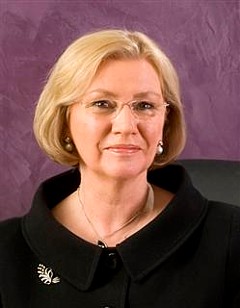reflexology
As promised in my last post about Edinburgh Napier University, I wrote to the vice-chancellor of the university, Professor Dame Joan K. Stringer DBE, BA (Hons) CertEd PhD CCMI FRSA FRSE, to invite her to respond.
|
7 February, 2011 Dear Professor Stringer, I should be grateful if you could let me know about your opinion of the degrees that you offer in Aromatherapy and Reflexology I have posted on my blog a bit of the material that was sent to me as result of recent FoI requests. See https://www.dcscience.net/?p=4049 I submit that degrees like this detract from the intellectual respectability of what is, not doubt, in other respects a good university, but since you are mentioned in the post, it’s only fair to give you the chance to defend yourself. In fact you’d be very welcome to do so publicly by commenting on the post. Best regards David Colquhoun |
Over a month later, I have received no response at all. This seems to me to be a bit discourteous.
There is nothing new in failing to get any answer to letters to vice-chancellors. The only VC who has ever thanked me for opening his eyes is Terence Kealey, of the University of Buckingham. All the rest have stayed silent. I can interpret this silence only as guilt. They know it’s nonsense, but dare not say so. Of course it isn’t infrequent for the course to close down after public exposure of the nonsense they teach. So perhaps the letters get read, even if they don’t elicit a reply.
Meanwhile the university sent me more materials that are used to teach their students. So here is another sample, largely from what’s taught to the unfortunate “reflexology” students.
Remember, these pre-scientific myths are not being taught as history or anthropology. They are taught as though they were true, to students who are then let loose on patients, so they can make money from anyone who is gullible enough to believe what they say.
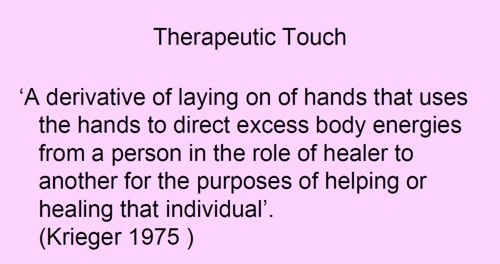
There are no "excess body energies". It’s made-up nonsense.
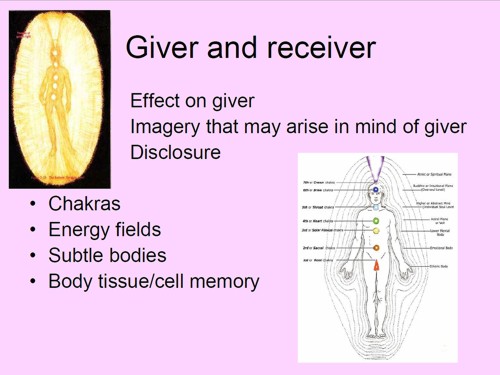
The diagram is pure imagination. It dates form a time before we knew anything about physiology, yet it is still being taught as though it meant something.
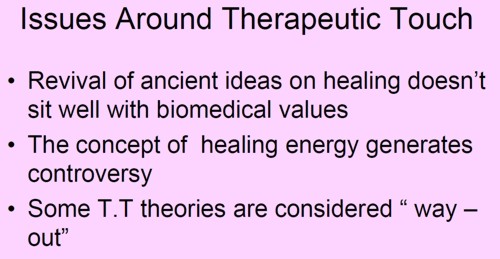
The admission that there is controversy is interesting. But it doesn’t seem to deter Napier’s teachers in the slightest.
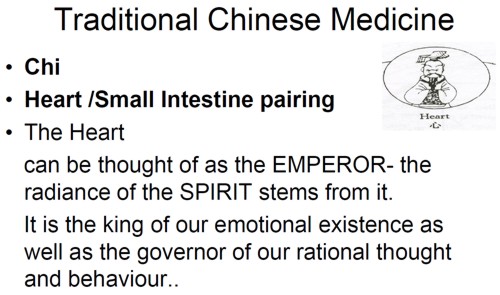
How can anyone in the 21st century believe that the heart is "king of our emotional existence”?. That’s just preposterous pre-scientific myth,
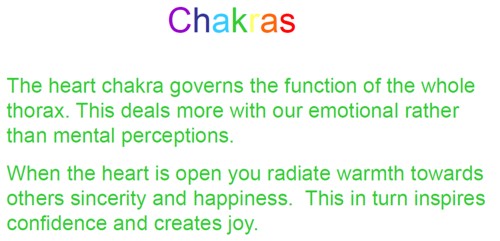
You must be joking.
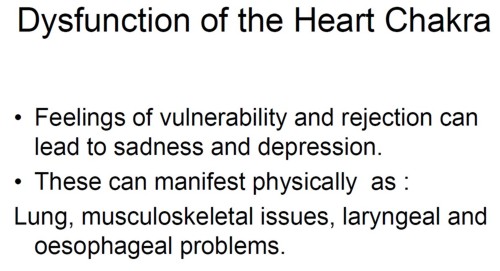
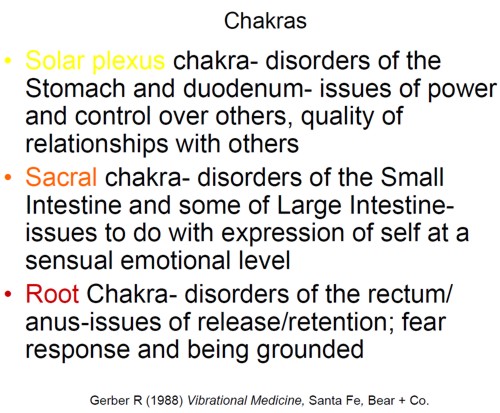
"Vibrational medicine" is a non-existent subject. Pure gobbledygook.
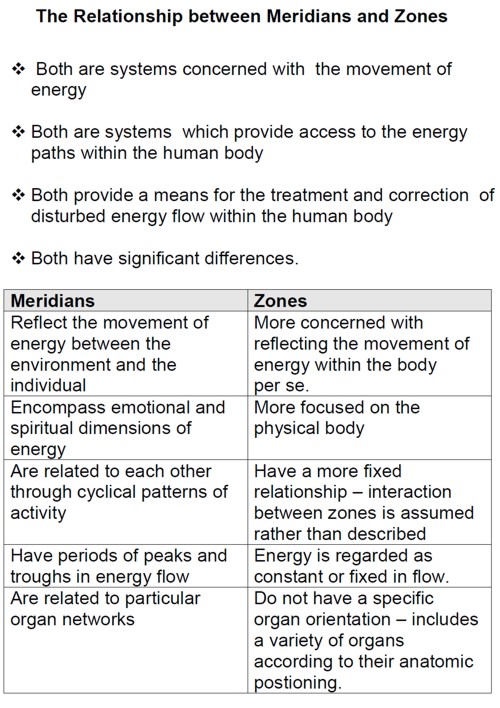

This is partly old, partly quite new. It is all preposterous made-up nonsense. There isn’t the slightest reason to think that "zones" or "meridians" exist. In fact there is good evidence from acupuncture studies to think that they don’t exist.
Now some slides from course CPT08102. The mention of the word ‘energy’ in the alternative world always rings alarm bells. Here’s why.

Well, it’s a good question. Pity about the answer.

Shouldn’t that read "as a practising reflexologist it is important than you have a MISunderstanding of the energy that surrounds us"?.

![]()
What logic? Have these people never heard of Hodgkin & Huxley (the answer, I imagine, is no)?
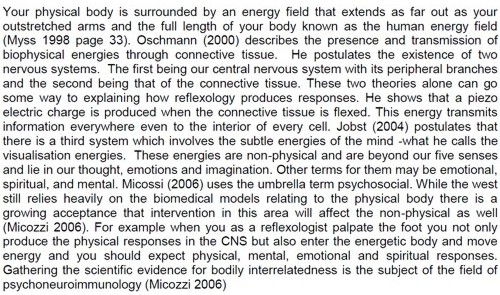
The mention of Kim Jobst immediately raises suspicions. He is a homeopath and endorser of the obviously fraudulent Q-link
pendant.
"when you as a reflexologist palpate the foot you not only produce the physical responses in the CNS but also enter the energetic body and move energy , , ". Well, no you don’t. This is purely made-up nonsense. The words sound "sciencey" but the meaning of the words is utterly obscure.
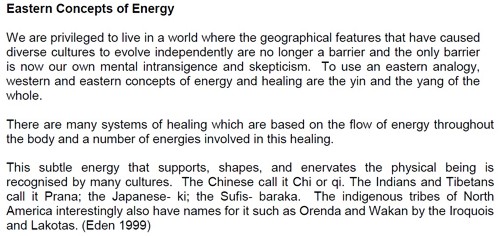
Yes we do live in an interconnected world. And sadly, that interconnectedness is used to spread myth and misinformation, usually with the aim of making money.
I guess Edinburgh Napier University makes money by teaching ancient myths as though they were true. In so doing they destroy their academic reputation.
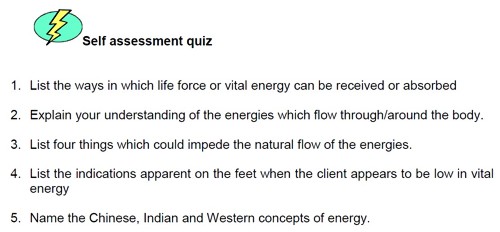
Here you are tested to see how much nonsense you have memorised successfully. If only they had sent ‘model answers’.
Remember, these pre-scientific myths are not being taught as history or anthropology. They are taught as though they were true, to students who are then let loose on patients, so they can make money from anyone who is gullible enough to believe what they say.
A 2009 systematic review of randomised controlled trials concludes that “The best evidence available to date does not demonstrate convincingly that reflexology is an effective treatment for any medical condition.”. So forget it.
How about it Professor Stringer? Isn’t it time to clean up your university?
Follow-up
|
In 2009 I asked Napier University Edinburgh for details of what was taught on its herbal medicine "BSc" course. At first it was refused, but then (as often seems to happen when threatened with exposure) the course was closed, and Napier sent what I’d asked for without waiting for the judgement from the Scottish Information Commissioner, |

|
Some samples of the dangerous nonsense that used to be taught on Napier’s herbal medicine course (now closed) have been exposed in “Hot and cold herbal nonsense from Napier University Edinburgh: another course shuts“.
That sadly doesn’t mean that Napier has stopped teaching nonsense. It offers a 3 year Honours BA degree in "reflexology" (the only other place in UCAS is the University of Wales Institute, Cardiff (UWIC), which offers a “BSc(Hons)”, though nine other places offer foundation degrees or HND)
Napier also offers a BA (Hons) in Aromatherapy, according to UCAS
Clearly quackademia has not died entirely yet, though it is on its way. It has closed down entirely at the University of Salford and the University of Central Lancashire. And when I wrote about quackademia in Nature in 2007 there were five "BSc" degrees in homeopathy. Now UCAS does not list a single one. It has even vanished in the home of woo, the University of Westminster.
When I asked Napier for teaching materials used in reflexology and aromatherapy, the request was, as usual. refused. In a letter dated 20 August 2010, David Cloy, Head of Governance & Management Services, wrote that disclosure of the materials “. , would be substantially prejudicial to the Universitys [sic] commercial interests”.
Scotland has its own Freedom of Information (Scotland) Act, and its own Information Commissioner, so it wasn’t possible to rely on the win that I had with the Information Commission (England and Wales). An Appeal was duly lodged on September 3rd 2010. They were a lot faster than before and their decision, dated 9 December 2010, was again almost completely in my favour [download the whole decision]. The decision ended thus.
The Commissioner finds that Edinburgh Napier University (the University) failed to comply with Part 1 of the Freedom of Information (Scotland) Act 2002 (FOISA) in responding to the information request made by Professor Colquhoun. The University wrongly withheld information under section 33(1)(b) of FOISA, and thereby failed to comply with section 1(1) of FOISA. It also failed to provide Professor Colquhoun with notice that certain of the information he had requested was not held, as required by section 17(1) of FOISA. The University also failed to provide Professor Colquhoun with reasonable advice and assistance in relation to his information request, as required by section 15(1) of FOISA.
The Commissioner therefore requires the University to provide the withheld information, and the advice detailed in paragraph 16 of this decision notice, by 27 January 2011.
There is quite a lot of material, so I’ll restrict myself to a few quotations.
Therapeutic Touch
This makes an interesting example because it is so obviously fraudulent. It is particularly interesting because of a famous paper published in 1996, in the Journal of the American Medical Association (read the paper) by Emily Rosa aged 9. She devised a simple experiment that showed convincingly that healers could not do what they claimed. Nobody has ever detected the magic rays that are said to emanate from the hands of the ‘healer’/confidence trickster. It is all pure make-believe. Like so many things of its sort, there is no ancient wisdom involved. It was invented in 1977 by a nurse. Watch the video of the test on YouTube, or the less reverent version by Penn and Teller. Also worth reading is Why Therapeutic Touch Should Be Considered Quackery.
I was sent a set if slides that are used for teaching students at Edinburgh Napier University about "Therapeutic Touch" (part of course CPT08104 “Pathophysiology Insights to Practice”)..
When reading these, remember that this is not a course on cultural history, or a course about the pre-scientific beliefs of primitive tribes as in anthropology. It is taught to students to enable them to charge money to sick and desperate people.
|
Rogerian Perspectives on Therapeutic Touch
– seen as a knowledgeable and purposive patterning of patient-environment energy field process in which (the nurse) assumes a meditative form of awareness and uses her/his hands as a focus for the patterning of the mutual patient-environment energy field process”. Four Principal (Conceptual ) Building Blocks. Energy Fields. The fundamental unit of the living and the non living” (Rogers 1986).
Openness
|
|
Pattern – the distinguishing characteristic of the energy field. A very useful concept – it helps with understanding the uniqueness of the individual – human existence and movement of energy. Patterns of relating – responding
Pan-dimensionality – a non-linear domain without special / temporal attributes
|
|
Rogers model also has 3 cardinal principles. Three Principles of Homeodynamics:
Teilhardt de Chardin (Essay on Human Spirituality) A comparative Explanation of Rogers’ laws of Homeodynamics )
|
All of this is so many meaningless words. It has the vaguely sciencey sound beloved of quacks (and post-modernists), but it is a million miles from science.
Empirically it just doesn’t work.
Sadly the slides from Napier did not include any helpful illustrations, but these two, from a similar lecture given at the University of Westminster should make it all clear.
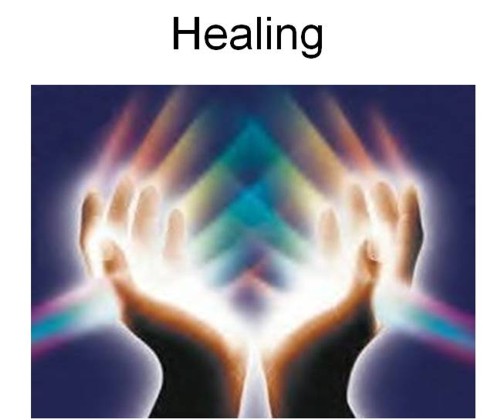
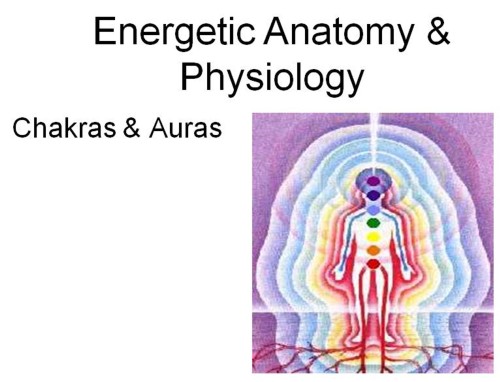
Aromatherapy
There’s some perfectly sensible stuff about the chemistry of essential oils. It’s when it comes to what they are good for that things rapidly come unstuck. Table 17 (extracted from a handout on essential oil chemistry) has all sorts of suggested uses
Energising
Essential oils can correct deficits or blockages in energy
Difficult to back up with scientific research, but nevertheless an important property in aromatherapy
Synergistic blending using the energetic approaches
So it is "important" but there is no evidence for it. The Table is prefaced by a disclaimer of sorts.
There is a body of anecdotal information concerning the potential therapeutic actions of essential oils, such as their anti-inflammatory, sedative and analgesic effects (Bowles 2003).
Despite some of the potential uses of essential oils contained in Table 17, it is not the role of the aromatherapist to treat specific conditions such as infections. However, the therapist can include appropriate oils in a holistic context, and can offer aromatherapy support preparations for home use.
At this point the handout does give quite strong hints that there is no good evidence that any of it works. In that case, why are they doing a three year degree in it?
Then of course we get on to the 19th century vitalism (being taught in the 21st century) and the usual ‘energy’ nonsense. For example
Holmes (1997) proposed that the nature of a fragrance can bring about specific psychotherapeutic effects. Using three fragrance parameters – tone (odour quality), intensity and note (evaporation rate), with tone being the most significant, and six fragrance categories – spicy, sweet, lemony, green, woody and rooty. He proposes that the nature of a fragrance will bring about specific psychotherapeutic effects. The following is a summary of his suggestions.
‘High/Top tone’ oils such as those from the citrus group, the Myrtaceae family and also ylang ylang extra and 1, lavender and mimosa abs. will have a stimulating, uplifting effect.
‘Low/Base tone’ oils including vetivert, patchouli, sandalwood and also tuberose, hay and oakmoss abs., will have a depressing, sedating effect.
Gabriel Mojay is quoted as saying
“Fragrance is the primary effective quality of essential oils. By this we mean their most immediate and generalised effect on the body and mind. This effect is first and foremost an energetic effect – as it is the vital energy of the human organism that first responds to an essential oil and its fragrance.”
These are just more empty words, woolly thoughts about long-discredited ideas of vitalism. They are presented entirely uncritically.
Reflexology
Reflexology is based on the utterly barmy proposition that "… reflexologists claim to be a system of zones and reflex areas that they say reflect an image of the body on the feet and hands, with the premise that such work effects a physical change to the body".
Regardless of its absurd premises, it just doesn’t work. A review by Ernst (2009) concludes
"The best evidence available to date does not demonstrate convincingly that reflexology is an effective treatment for any medical condition."
It is simply a foot massage, There’s nothing wrong with that, if you like that kind of thing, but please don’t pretend it is anything more
One handout lists, under the treatments for Migraines and Headaches
- Homeopathy (applying the principle of similimum)
- Herbal
- Massage for relaxation
- Reflexology (addressing reflexes relating to head, neck, solar plexus, spine, pituitary & digestive systems).
- Nutritional therapy
- Accupressure.[sic]
- Bach Flowers may be useful
No evidence is cited for any of them, not doubt because next-to-none exists.
A three year degree in rubbing feet is just an absurdity.
The material that was sent about reflexology was very thin. I’ve asked for more, but in a sense it doesn’t matter, because all one has to do is look at a standard reflexology diagram to see what a load of unmitigated nonsense it is. There isn’t the slightest reason to think that an area on your big toe is ‘connected’ in some unspecified sense, to you nose, It is just preposterous made-up junk.
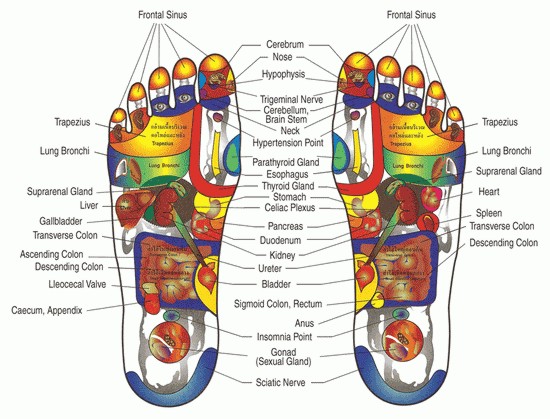
Diagram from Scienceblogs
Who is responsible?
I’m quite happy to believe that the people who teach this new-age nonsense actually believe it.
|
What I would like to know is whether the Principal and Vice-Chancellor of Edinburgh Napier University believes it. She is Professor Dame Joan K. Stringer DBE, BA (Hons) CertEd PhD CCMI FRSA FRSE. That’s an impressive string of initials for somebody who seems to defend 19th century vitalism as a suitable subject for an honours degree. I could ask her, but such letters rarely get a response. |
Follow-up
|
Yesterday I was fired from the Conduct and Competence Committee of the CNHC. That is the organisation that was very quickly dubbed Ofquack in the blogosphere. So now I am free to write what I like about about it. |
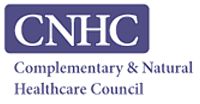
|
It has now become clear that voluntary self-regulation can not work. Recent events at the CNHC show how it has become a victim of its own rules [skip the background].
Background | Complaints | Why CNHC won’t work |
Background
The CNHC was the product of the late unlamented Prince of Wales’ Foundation for Integrated Health. The Prince’s Foundation was paid a large amount of taxpayers’ money, £900,000, by the Department of Health to come up with a scheme for voluntary self-regulation of various sorts of alternative medicine.
There is, as usual, an enormous amount of relevant information can be found on the ebm-first site.
I posted a bit about Ofquack just before I joined them. There were two main points. One was to draw attention to the wonderful account of CNHC by Polly Toynbee, "Quackery and superstition – available soon on the NHS", The other was to point out an obvious problem with the job they were supposed to do.
“What won’t work is to insist that homeopaths are “properly trained”. If one takes the view that medicines that contain no medicine can’t work, then years of being trained to say that they do work, and years spent memorizing the early 19th century mumbo-jumbo of homeopathy, does not protect the public, it imperils them.”
On 25 September 2008, someone sent me an advertisement for a job on the conduct and competence committee. The job description seemed to fit me quite well, so I applied. I presumed they wouldn’t take me, and then I could write a blog about it. But after a phone interview with co-chair Maggy Wallace, I was amazed to be offered the job.
Since joining them I haven’t actually done anything whatsoever, apart from offering a few general ideas, because no cases have actually reached the Conduct and Competence Committee.
This was the first time I had encountered a quango at first hand. Several of the members seemed to have no great interest in medicine, or even in alternative medicine. They were more interested in regulation per se, or at least the sort of pseudo-regulation that most of these bodies mostly seem to offer. They seem to suffer from the well-known delusion that you can manage/regulate something without knowing anything about it. In cases such as this one, where what is being regulated is largely nonsense, there are bound to be problems.
There were two people, whom I did come to like particularly, Maggy Wallace and John Lant. They were both willing to talk and to listen.
The anonymous emails
The alternative medicine community took a surprisingly long time to notice my presence, but on 19 May 2010 a pretty vicious anonymous email arrived at the CNHC, complaining about me. Here it is.
|
Received: from exprod8mo105.postini.com ([64.18.3.61]) by cnhc.org.uk with Microsoft SMTPSVC(6.0.3790.4675); Wed, 19 May 2010 10:45:24 +0100 Received: from exprod8mc102.postini.com (exprod8mc102.postini.com [64.18.3.241]) by exprod8mo105.postini.com (Postfix) with SMTP id D80135A8726 for <info@cnhc.org.uk>; Wed, 19 May 2010 02:45:23 -0700 (PDT) Received: from source ([72.14.220.155]) by exprod8mx290.postini.com ([64.18.7.10]) with SMTP; Tue, 18 May 2010 08:56:11 MDT MIME-Version: 1.0 Return-Path: <colquhounalertcnhc@gmail.com> X-OriginalArrivalTime: 19 May 2010 09:45:25.0002 (UTC) FILETIME=[019176A0:01CAF738]
Thread-Topic: CNHC and Colquhoun
From: “Sara McGlouglan” <colquhounalertcnhc@gmail.com> Colquhoun and the CNHC (Complementary and Natural Health Care Council) What is the CNHC and why does it exist? REFLEXOLOGY IS BOLLOCKS! Nutritional therapy self-styled ‘nutritionists’; making untrue claims about diet in order to sell you unnecessary supplements. Reiki: tea and sympathy, accompanied by arm-waving. Shiatsu uh? It seems the teacher is already committed to placebo medicine. [All the above quotes; and many more stated by David Colquhoun, CNHC Panel member] Contents 1: Colquhoun and CNHC 2: More statements from Colquhoun 3: Want some more!!! 4: What to do 1. Colquhoun and CNHC Colquhoun is a man who has steadfastly attacked, denigrated and taken all steps he can to undermine those involved in natural health. Yet Colquhoun is now (and has been for more than a year) a member of the CNHC’s Conduct and Competence Committee. The role of CNHC is to regulate the professions of their members. But what is the rational behind allowing an avowed critic of natural medicine onto the Conduct and Competence Committee. Isn’t this like asking racist to be objective about the circumstances of racist crime? Would you, as a practitioner having to answer to a complaint, be happy to have one of the panel members think your profession is ‘bollocks’ or that everything you practice is fraudulent from the start? Latest moves from the government now aim at putting all Herbal Practitioners under the authority of CNHC. Do you want your personal and confidential data, and that of your patient/client in the hands of Colquhoun? What might happen to it? Certainly every practitioner has to be responsible for their actions and practice but since when has it been standard practice to weigh the scales against you rather than be assessed by a panel of independent peers? 2. More statements by Colquhoun ‘ nonsense, untrue, unnecessary, rectal obsession, mystic barmpot, fraud, theatrical placebo‘ In his "Patients’ guide to Magic medicine” [https://www.dcscience.net/?page_id=733] Colquhoun summarizes many of the CNHC members’ professional activities (and other professions too) as follows: * Reflexology: plain old foot massage, overlaid with utter nonsense about non-existent connections between your feet and your thyroid gland. * Nutritional therapy: self-styled ‘nutritionists’ making untrue claims about diet in order to sell you unnecessary supplements. * Spiritual healing: tea and sympathy, accompanied by arm-waving. * Reiki: ditto. * Angelic Reiki. The same but with added Angels, Ascended Masters and Galactic Healers. Excellent for advanced fantasists. * Colonic irrigation: a rectal obsession that fails to rid you of toxins which you didn’t have in the first place. * Anthroposophical medicine: followers of the mystic barmpot, Rudolf Steiner, for whom nothing whatsoever seems to strain credulity * Alternative diagnosis: kinesiology, iridology, vega test etc, various forms of fraud, designed to sell you cures that don’t work; for problems you haven’t got. * Homeopathy: giving patients medicines that contain no medicine whatsoever. * Herbal medicine: giving patients an unknown dose of an ill-defined drug, of unknown effectiveness and unknown safety. * Acupuncture: a rather theatrical placebo, with no real therapeutic benefit in most if not all cases. So what kind of organisation is CNHC and why have they put him on to their Conduct and Competence panel? Being a CNHC member seems to be like inflicting pain on yourself. CNHC also received funding from the Prince’s Foundation for Integrated Health (FIH). Yet Colquhoun regularly lambasts the FIH and Prince Charles himself categorizing him as a ‘champion of endarkenment’ [https://www.dcscience.net/?p=2544] and calling the FIH the Foundation Fellows of the Prince of Wales Foundation for Magic Medicine, an organisation that is at the forefront of spreading medical misinformation. [https://www.dcscience.net/?p=2131] Of course, no one expects that because an organisation provides funding it should be exempt from criticism but surely, if you are working for an organisation whose purpose is to represent standards in a certain field, why would you have someone on your management team who fires out carping criticism at the supporting organisation, its practitioners and its practices unless perhaps, it is your purpose to spread discord and cut the funding. No wonder the CNHC has problems. Their business plan (contingent on funding) was initially to have more than 10,000 enrolled members. This has been revised down to 2,000 and by all counts they have not even made this. Not surprising if the practitioners whom you represent don’t have any trust in the organisation that is supposed to represent the standards of your profession. 3. Want some more!!! fantasists, wrong and dangerous, largely quackery, lies, mumbo-jumbo, made-up fantasies, placebo medicine On nutritional therapy It is interesting to compare the high standards of the Nutrition Society with the quite different standards of BANT (the British Association for Applied Nutrition and Nutritional Therapy).& They bill themselves as the “Professional Body for Nutritional Therapists”. Nutritional therapists are those fantasists who believe you can cure any ill by buying some supplement pills. [https://www.dcscience.net/?p=1391] [On quotes taken from Nutritional Therapy text] That must be about as close as you can get to claiming you can prevent cancer by taking vitamin pills. It is wrong and t is dangerous, Sigh. What century are we living in? [https://www.dcscience.net/?p=555] Everyone is for good nutrition of course, but ‘nutritional medicine’, or ‘nutritional therapy’ pretends to be able to cure all sorts of diseases by changes in diet or by buying expensive nutritional supplement pills. It has no perceptible relationship to the very important subjects of ‘nutrition’ or ‘dietetics’.. ‘Nutritional therapy’ is very firmly part of alternative medicine, in other words it is largely quackery. If you don’t believe that, read on. https://www.dcscience.net/?p=260 On Reflexology As usual, not many seemed to care very much about the secondary consequences of employing a ‘reflexologist’, namely that some poor kid has to memorise a bunch of lies to get the piece of paper demanded by HR (and the taxpayer has to fund it). https://www.dcscience.net/?page_id=237 What is the evidence about ‘spiritual healing’ ? Very little it seems. No doubt, mumbo-jumbo can make some people feel better, and to that extent it is justified. But it can and should done be honestly (for example, foot massage is fine, ‘reflexology’ isn’t). Lies to patients should be minimised and universities should not be tempted to hand out certificates in mumbo jumbo. https://www.dcscience.net/?p=34 Michael McIntyre has the first of several long speeches, advocating more research. There was an advertisement for his web site “promotes best practice” (allegedly). He talks quite seriously about “reflexology” and so on, as though it were real subject (it isn’t; its “principles” are made-up fantasies). https://www.dcscience.net/?p=2813 Much of what they do at the Christie is straightforward massage, but they also promote the nonsensical principles of ‘reflexology’ and acupuncture. https://www.dcscience.net/?p=1466 The hilarious Radio 4 programme, The News Quiz had a good joke. Jeremy Hardy was asked which patients are hoping for a more robust constitution?. This referred to the £1m PR exercise mounted by the NHS to launch the NHS constitution. Hardy said that in the week when Barack Obama was inaugurated, and the word constitution have a whole different sort of gravitas in a week like that. "I think the constitution should open with the words “We hold these truths to be self-evident REFLEXOLOGY IS BOLLOCKS" https://www.dcscience.net/?page_id=237 On Shiatsu Shiatsu uh? It seems the teacher is already committed to placebo medicine. https://www.dcscience.net/?p=454 4. What to do Why join an association that condones the above? Many have never joined CNHC because of this and other issues whilst existing CNHC members do not want to remain members. 1. Contact your professional association and insist that they do not join CNHC. 2. If your association is already a member then make a complaint and insist that your personal details are not supplied to CNHC. 3. There are other associations in existence that have the same purpose as CNHC. Find out about them. You (or your professional association) have the option to join them and 4. Please pass on this information to anyone else that you know. It is important that we are represented honestly and with integrity. The actions of CNHC do not add up. ooOOoo |
Nobody seems to know the real name of Sara Glougan (aka Sam McGlougan. The letter is, I suppose, fair enough. I did say most of those things. What’s objectionable is that the anonymous writer seems to think that my opinions disqualify me from judging dispassionately a Conduct and Competence case. What this letter really says is that "we don’t want anyone who cares about the truth of claims to have any power over us". They just don’t want to be regulated in any effective way. The co-chair, Maggy Wallace, is a bit more sensible than that. The reason that I was appointed by her was because of my knowledge about how to assess evidence. But that isn’t a topic that interests alternative medicine advocates.
The fact of the matter is that the CNHC has been signing up people at a far slower rate than it hoped originally. It is in dire financial trouble (see, for example, Will the government bail out Ofquack?>, and CNHC’s report to the Department of Health in June 2009, obtained under the Freedom of Information Act.. The last thing they can afford is anything like this letter, which might reduce the registration rate still further. So it was inevitable that they had to get rid of me. Initially I was invited to resign on grounds of bad health. I didn’t, so on 10 August 2010 I was asked to appear before the board to be fired (in the nicest possible way). The CNHC now has nobody with any statistical expertise. Needless to say I’m not heartbroken about it. It was a waste of time for me, but it did provide a valuable insight into how voluntary self-regulation works, or rather fails to work.
The complaints against reflexologists
The CNHC has a complaints procedure, though its operation is somewhat tortuous.. As soon as they started to register reflexologists, several complaints were sent by the indefatigable Simon Perry (read his account)
“The ad suggests that reflexology is suitable for treating babies with colic, IBS and arthritis. She also claims to have experience in treating fertility issues. There is no reliable evidence to suggest that reflexology is capable of treating [these] issues.”
This complaint never came to to the Conduct and Competence Committee. It didn’t get past the preliminary Investigating Committee (chaired by John Lant), the job of which is to see if there is a case to answer. They decided that the advertisements in question did indeed breach paragraph 15 of the CNHC’s Code of Conduct, Performance and Ethics (see below). All 14 of Simon Perry’s complaints were upheld. However the Investigating Committee Panel’s report went on to say, apparently on the advice of the ‘Profession specific boards’ that
“The ICP found that the registrants’ Fitness to Practise was not impaired, because they did not deliberately seek to mislead their clients or to exaggerate the benefits of the therapy which they described in good faith. However they found that the registrants had made claims about the therapy offered which appeared to imply more efficacy than evidence necessarily provides.”
That, presumably, is why the complaints never reached the Conduct and Competence Committee. There was no case to answer.
One must admire Maggy Wallace’s statement that she “place on formal record their thanks to Simon Perry for bringing this matter to their attention.”. Never the less the problem is glaringly obvious and it shouldn’t have need a complaint.
Why ofquack can never work
The complaint episode is fascinating. The CNHC has clearly painted itself into a corner. It has brought to the fore all the contradictions that are inherent in what they are trying to do.
They have decided that reflexologists make false claims about what they can achieve.
But they decided it wasn’t the fault of the reflexologists because that is what they had been taught
Therefore the CNHC has judged that fitness of reflexologists to practise is not affected by the fact that they make false health claims.
That means that the CNHC judges that the public safety is not affected by whether their members make false health claims. That seems ludicrous enough, but it goes further
In the initial publicity it was often said that the job of the CNHC was safety -their job to protect the public, not to judge whether treatments worked or not. That sort of statement is contradicted directly by paragraph 15 of their Code of Conduct, Performance and Ethics, which reads thus.
15. You must follow CNHC guidelines in relation to advertising your services
Any advertising you undertake in relation to your professional activities must be accurate. Advertisements must not be misleading, false, unfair or exaggerated. You must not claim that your personal skills, equipment or facilities are better than anyone else’s.
If you are involved in advertising or promoting any other product or service, you must make sure that you use your knowledge, healthcare skills, qualifications and experience in an accurate and professionally responsible way. You must not make or support unjustifiable statements relating to particular products or services. Any potential financial rewards to you should be made explicit and play no part at all in your advice or recommendations of products and services that you give to patients, clients and users.
This paragraph places on the CNHC the responsibility for judging whether or not a treatment does what’s claimed for it. With my departure, there is really nobody left who is well-qualified to do that,
but nonetheless, their judgement on claims made by reflexologists was quite right.
The assertion by the CNHC that the false claims were OK because that is what reflexologists are taught is a direct admission that the courses that ‘train’ reflexologists are teaching them to say things that are not true. Of course the rest of the world knew that already, but to have it admitted by the CNHC is amazing.
Part of the job of the CNHC is to judge whether registrants are properly trained. But they have just decided that courses for reflexologists teach them to say things that aren’t true, That leaves the CNHC it an impossible position. By accepting reflexologists, they are saying that it doesn’t really matter that they are taught to make false claims, The criteria for entry include
“Have undertaken a programme of education and training which meets, as a minimum, the National Occupational Standards for that profession/discipline”
This shifts the responsibility for deciding what’s acceptable to National Occupational Standards and Skills for Health. Neither of these quangos is in the least concerned about what’s true and what isn’t. That’s not surprising when you realise who drafted all the HR style nonsense to be found at Skills for Health? None other than the late Prince of Wales’ Foundation. The stuff produced by them isn’t worth the paper it’s written on. There is something about Skills for Health in the post where I recount a phone call with them, When I asked whether they would produce standards for talking to trees, I was referred, in all seriousness, to LANTRA, the Land based skills council. You couldn’t make it up.
The National Occupational Standards (NOS) directory leads to the NOS for reflexology. The preamble says
Reflexology is the study and practice of treating reflex points and areas in the feet and hands that relate to corresponding parts of the body. Using precise hand and finger techniques a reflexologist can improve circulation, induce relaxation and enable homeostasis. These three outcomes can activate the body’s own healing systems to heal and prevent ill health.
There is, if course, not a shred of reason to think that “areas in the feet and hands that relate to corresponding parts of the body”. This statement alone would fail the CNHC’s code of conduct. National Occupational Standards in this area are simply a farce.
What will the CNHC do about these paradoxes? The complaint report said
“The ICP have asked Maggie Dunn, the CNHC Registrar, to initiate, as a matter of priority, discussions with the CNHC’s Profession Specific Boards and the Professional Fora to agree advice to registrants in relation to paragraph 15.”
I was told that this might take between 3 and 5 years to do. But I have a strong feeling that it will never be done in any effective way. If the CNHC prevented training courses from teaching students to make claims that aren’t justified by evidence, just about every course would close and the CNHC would crumble to dust. The result would be the ultimate irony. Alternative medicine would be abolished, not by skeptics, but by the CNHC.
That follows inevitably from the complaint judgement combined with paragraph 15 of the code of conduct.
It will be fascinating to see how the CNHC tries to escape from the grave that it has dug for itself.
If the CNHC implements properly its own code of conduct, few people will sign up and CNHC will die. If it fails to implement its own code of conduct it would be shown to be a dishonest sham.
Follow-up
Interview for Pod Delusion on the CNHC case
We know all about the sixteen or so universities that run “BSc” degrees in hokum. They are all “post-1992” universities, which used to be polytechnics. That is one reason why it saddens me to see them destroying their own attempts to achieve parity with older universities by running courses that I would regard as plain dishonest.
Older universities do not run degree courses in such nonsense. Academics (insofar as they still have any influence) certainly would not put up with it if they tried. But nevertheless you can find quackery in some of the most respected universities, and it gets there not via academics but (guess what) via Human Resources. It creeps in through two routes. One is the “training courses” that research staff now have to do (the “Roberts agenda”). The other route is through occupational health services.
Quackery in training courses
It isn’t easy to find out what happens elsewhere, but I was certainly surprised to find out that UCL’s own HR department was offering a course that promised to teach you the “core principles” of Brain Gym and Neurolinguistic Programming, both totally discredited bits of psycho-babble, more appropriate to the lifestyle section of a downmarket.women’s magazine than a university. I gather that HR’s reaction after I brought this to light was not to ask what was wrong with it, but just to get angry.
In a spirit of collegiality I offered to run a transferable skills course myself. I even offered to do it for nothing (rather than the rumoured £700 per day charged by the life style consultants). I proposed a course in ‘How to read critically’ (subtitle ‘How to detect bullshit’). This seems to me to be the ultimate transferable skill. Bullshit occurs in every walk of life. My proposal was moderately worded and perfectly serious.
Guess what? Despite several reminders, I have never had any response to my suggestion. Well, I suppose that HR people now regard themselves as senior to mere professors and there is really no need to reply to their
letters.
Quackery in occupational health. Leicester sets a good example
If you work at a university, why not search the university’s web site for “complementary medicice” or complementary therapies”. If it is a real university, you won’t find any degrees in homeopathy, or in amethysts
that emit high yin energy. But some quite surprising places are found to be recommending magic medicine through their Occupational Health service, which usually seems to be part of HR. In fact at one time even UCL was doing it, but no soon had somebody sent me the link than it disappeared. As a matter of historical record, you can see it here (it had all the usual junk, as well as harmless stuff like yoga and pilates).
While looking for something else I stumbled recently some other cases. One was at the University of Leicester, a very good university (and alma mater to the great David Attenborough who must have done more to point out the beauty of science than just about anyone). But we find on their staff wellbeing site, alongside some perfectly sensible stuff, a link to complementary therapies.
The list of ‘therapies’ includes not only the usual placebos, acupuncture, reiki, reflexology, but, even more exotically, a fraudulent Russian device called SCENAR therapy. They have a nice leaflet that explains all these things in words that run the whole gamut from meaningless gobbledygook to plain wrong. Here are some examples from the leaflet.
Reflexology
“In the feet, there are reflex areas corresponding to all the parts of the body and these areas are arranged in such a way as to form a map of the body in the feet”
Reflexology has been shown to be effective for:
- Back Pain
- Migraine
- Infertility
- Arthritis
Well no, there are no such areas in your feet. That is sheer imagination. And reflexology has not “been shown to be effective” for any of those conditions. These claims for therapeutic efficacy are not only lies. They are also illegal.
“Reiki
Each hand position is held for a few minutes, and during this time healing energy will flow into you, balancing your energy system, releasing stress, soothing pain, and promoting your body’s natural ability to heal itself.”
This is sheer idiotic mumbo-jumbo. The “flow of healing energy” is totally imaginary. Such talk is offensive to anyone with half a brain. Insofar as they claim to heal anything, it is also illegal. The comes SCENAR.
“What is SCENAR?
SCENAR is an acronym for Self Controlled Energo- Neuro Adaptive Regulator. It is a reflex biofeedback device which when used by a qualified practitioner, can help to alleviate acute and chronic pain. It is licensed in the UK for pain relief but experience has shown that it is helpful in a wide variety of conditions.”
This is even more seriously nuts than the others. The term “licensed” means merely that it is electrically safe. It certainly does not mean that it works. Pubmed shows only three publications about the SCENAR device, all in Russian,
One sales site (apparently Russian) makes the following modest claim.
“A prime goal of the Russian Space Program was to provide space travelers with a portable medical device that would become their “universal medical assistant” in space. So from the beginning, the SCENAR was designed to replace an entire medical hospital, with all its staff, diagnostic and treatment facilities, even the pharmacy. A universal, non-invasive, portable regulator of body functions (among other things) was envisaged.”
The SCENAR device (right) looks like a TV remote control (perhaps it IS a TV remote control -we aren’t anywhere told in comprehensible terms what’s in the box. The Russian site sells also the rather baffling accessory on the right. The mind boggles.

SCENAR device |
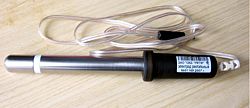
Remote rectal-vaginal electrode for SCENAR |
How does this rubbish get onto the web site of a good university?
I presume that it is just another sign of what happens when universities come to be run by non-academics. No doubt the occupational health people are well meaning and kind, but just scientifically illiterate. What about the HR person in charge of them? They are not known for scientific literacy either (which would not matter if they stuck to their job). But perhaps they just didn’t notice. There is only one way to find out. Ask. So I sent this letter.on 10th September.
| Hello
I am a pharmacologist and I have a side interest in public understanding of science, alternative medicine.and medical fraud I was quite surprised when Google led me unexpectedly to your complementary therapies page at http://www.le.ac.uk/staffwellbeing/complementary_therapy.html There is, sad to say, a great deal of information on these pages that is simply not true. For example it has NOT been shown that reflexology has been shown to be effective in any of the conditions which you list, as far as I know To take only one more example from this page, the SCENAR device is an even more extreme example. It is well known to be fraudulent. and has been investigated by the Washington State Attorney General. This sort of thing is not what one would expect from a very respectable university, and it must be a great embarrassment to your excellent medical scientists. Apart from the many scientific inaccuracies (which greatly impede the efforts of those of us who try to improve public understanding of science), you are, I hope, aware that there is a legal aspect. Since May this year, new regulations have made it illegal to make claims for health benefits if evidence cannot be produced to show that the claims are justified. I would like to put it to you that many of the claims made on this page are not only immoral, but also illegal. I wondered whether you , or your HR department, would like to make any comments Best regards David Colquhoun |
I got an immediate and very sympathetic response from the Director of HR and a week later, on17th September, he wrote
“Hi David,
I have discussed the matter with my manager of Staff Counselling and Welfare and have agreed that it is probably safest that we remove the references to ‘complimentary’[sic] therapies from the site entirely.
Thank you for your helpful input and the recommendations for reading matter.”
So there is a lesson here. If you find this sort or stuff on your own institution’s web site, all that may be needed is a simple letter that points out what nonsense it is. Admittedly the HR man seemed rather more worried about whether the claims were illegal than whether they were true, but either way, it worked.
Only one little snag. As of 6 October the pages still have not been removed.
On the assumption that they eventually will be removed, I have kept copies of the Wellbeing page, of the Complementary Therapies page, and of the ‘explanatory leaflet’. They stand as part of a historical record that
shows, once again, what can happen when scientific matters get into the hands of HR. Fortunately Leicester University has an HR director who is willing to listen to advice.
Follow-up
Something seems to have gone seriously wrong. Despite the rapid response, virtually all the nonsense is still there on 13th October. It seems not to be so simple after all.
And despite several reminders, the advertisement for SCENAR ‘therapy’ is still on the University web site on December 14th. I know that no decision by HR can be made with fewer than 25 meetings and an awayday in Majorca, but this is getting ridiculous.

